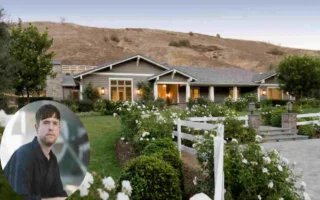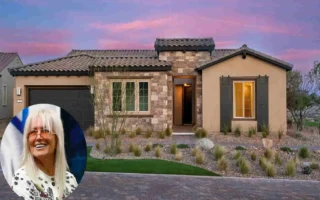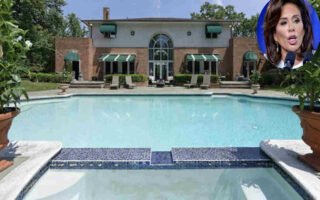When you think of Winston Churchill, what comes to mind? Perhaps it’s his defiant stance during World War II, his stirring speeches that rallied a nation, or maybe that famous cigar-wielding silhouette. But have you ever wondered about the man behind the legend? Where did he retreat after those long days of wartime leadership? Where did he find solace, inspiration, and the peace to paint his beloved landscapes?
The Winston Churchill house stands as more than just bricks and mortar. It’s a window into the soul of one of history’s most fascinating figures. This remarkable residence served as both a sanctuary and a command centre, witnessing pivotal moments that shaped the 20th century. Today, it offers us an intimate glimpse into Churchill’s private world.
The Historical Background of Winston Churchill’s Home
A Country Estate with Character
Nestled in the gentle hills of Kent, Chartwell – the most famous Winston Churchill house – became the statesman’s beloved country retreat in 1922. This sprawling estate, with its red-brick Victorian architecture and commanding views across the Weald, captured Churchill’s heart from the moment he first laid eyes on it.
The property dates back to the 14th century, though the house style Churchill purchased had been largely rebuilt in Victorian times. When Winston and his wife, Clementine, first visited, the estate was somewhat rundown and in need of extensive renovation. Despite Clementine’s initial reservations about the cost, Churchill was determined to make it his own.
Churchill’s Personal Haven
| Aspect | Details |
|---|---|
| Name | Chartwell |
| Location | Westerham, Kent, South East England, about 30 miles (48 km) southeast of London |
| Address | Near Westerham, Kent, England (exact historic address not publicly specified) |
| Architectural Style | Vernacular style with elements of classical and Gothic Revival; constructed of red brick with stone dressings |
| Architect(s) | Original house built in the 16th century; major rebuild and extension by architect Philip Tilden (1922-1924) |
| House Description | Two-story manor with basement and extensive attics; notable features include two circular towers and a large three-story garden front extension with stepped gables |
| Historical Use | Home of Winston Churchill from 1922 until shortly before his death in 1965 |
| Interior Highlights | Study, drawing room, Lady Churchill’s bedroom, custom dining room, painting studio (converted stables) |
| Grounds | Gardens and woodland, pond with feeding seat, large estate with views over the Weald of Kent |
| Historical Significance | Place where Churchill wrote books and speeches, hosted political figures, and enjoyed painting |
| Current Status | Open to the public as a National Trust property and museum, preserving original furnishings and memorabilia |
| Estimated Worth | Not publicly documented; considered historically priceless and a cultural heritage site |
| Notable Features | Underground bunker, indoor pool added by Churchill; orange tabby cat tribute (Jock) |
From 1924 until he died in 1965, Chartwell served as Churchill’s principal residence outside of London. Here, away from the pressures of political life, he could indulge in his many passions: painting, writing, bricklaying, and spending time with his growing family.
The house witnessed both triumph and tragedy in the Churchill family’s life. It was here that Winston mourned the death of his beloved daughter, Marigold, in 1921, even before he purchased the property. Later, it became a place of joy where his other children – Diana, Randolph, Sarah, and Mary – spent their formative years.
A Wartime Command Post
During the tumultuous years of World War II, the Winston Churchill house transformed into an unofficial command centre. Though security concerns meant Churchill spent most of the war years at 10 Downing Street or the underground War Rooms, Chartwell remained spiritually significant.
Military advisors and political allies would travel to Kent for crucial weekend conferences. The estate’s lakes were camouflaged to prevent German bombers from using them as navigational landmarks. Despite the dangers, Churchill insisted on visiting whenever possible, finding in Chartwell the peace and perspective needed to lead a nation at war.
The Golden Years
After the war, Chartwell truly came into its own. Churchill spent his “wilderness years” here, both before and after his political comebacks. The house became his writing studio, where he penned much of his monumental work “The Second World War,” which would later win him the Nobel Prize in Literature.
Architectural and Design Features of Winston Churchill’s Home

A House Shaped by Personality
The Winston Churchill house reflects its owner’s eclectic tastes and practical needs. When Churchill purchased Chartwell, he immediately set about transforming it to suit his vision. Working with architect Philip Tilden, he redesigned much of the interior while preserving the home’s essential character.
The exterior maintains its Victorian red-brick charm, but Churchill added his personal touches everywhere. Large windows were installed to flood the rooms with natural light – essential for his painting hobby. The famous study, with its standing desk where Churchill wrote many of his speeches and books, overlooks the gorgeous Kentish countryside.
Interior Treasures
Step inside, and you’ll find rooms that tell stories. The drawing room, with its comfortable chairs and well-stocked bookshelves, hosted everyone from Charlie Chaplin to Lawrence of Arabia. The walls display Churchill’s own paintings – he was a prolific amateur artist who found painting therapeutic.
The dining room showcases Churchill’s passion for fine living. The table, often set for distinguished guests, reflects the importance of conversation and companionship in Churchill’s life. You can almost hear the clink of glasses and the animated discussions that once filled this space.
Churchill’s Sacred Spaces
Perhaps no room captures Churchill’s essence better than his study. Here, surrounded by thousands of books, he worked at his standing desk – a habit he maintained throughout his life. The room remains much as he left it, with papers, photographs, and personal mementoes creating an atmosphere of a great mind temporarily set aside.
The painting studio reveals another side of Churchill entirely. Set up in the garden room, it’s filled with natural light and offers inspiring views. His easel, paints, and unfinished canvases remain, showing us Churchill the artist rather than Churchill the statesman.
Gardens of Contemplation
The grounds of the Winston Churchill house deserve special mention. Churchill personally helped design and build many features, including the famous brick walls around the kitchen garden – he was an enthusiastic amateur bricklayer and even joined the bricklayers’ union!
The gardens include:
- The Golden Rose Garden: Celebrating Churchill and Clementine’s golden wedding anniversary
- The Water Garden: Complete with lakes where Churchill kept his beloved golden orfe fish
- The Kitchen Garden: Where Churchill built walls and grew vegetables during the war
These outdoor spaces provided Churchill with physical exercise and mental respite, proving as crucial to his well-being as any room in the stunning house.
Key Events and Moments at Winston Churchill’s House

Where History Was Made
The Winston Churchill house witnessed countless moments that shaped modern history. Within these walls, Churchill made decisions that would affect millions of lives and alter the course of nations.
One of the most significant gatherings occurred in September 1940, during the height of the Battle of Britain. Churchill hosted a crucial meeting with his War Cabinet at Chartwell, despite the very real danger of German air raids. As Spitfires and Messerschmitts fought overhead, Churchill and his advisors planned Britain’s Survival strategy.
Distinguished Visitors and Memorable Meetings
Chartwell’s guest book reads like a “Who’s Who” of the 20th century. Charlie Chaplin entertained the family with impromptu performances in the drawing room. T.E. Lawrence (Lawrence of Arabia) discussed Middle Eastern politics over brandy. Albert Einstein engaged Churchill in discussions about the implications of the atomic age.
Perhaps most poignantly, General Charles de Gaulle visited during his London exile, and the two leaders – often at odds – found common ground walking Chartwell’s gardens. These personal connections, forged in the intimate setting of Churchill’s home, usually proved as crucial as formal diplomatic meetings.
Wartime Decisions
During the war years, several pivotal decisions were made at Winston Churchill’s house. In the study, Churchill drafted some of his most famous speeches, including early versions of “We shall fight on the beaches.” The dining room hosted secret meetings with intelligence chiefs, where Churchill reviewed Ultra intercepts that would guide Allied strategy.
One lesser-known story involves Churchill’s famous “Black Dog” – his term for depression. During particularly dark moments of the war, he would retreat to Chartwell to paint or build walls, finding in physical activity the strength to continue leading. The house served as both a refuge and a rejuvenation centre.
Family Life and Personal Moments
Beyond the grand historical events, Chartwell was simply home to the Churchill family. Birthday parties, Christmas celebrations, and Sunday lunches filled the house with laughter and life. Churchill’s grandchildren remember sliding down the bannisters and playing hide-and-seek in the vast rooms.
The house also witnessed tender moments between Winston and Clementine. Their bedroom windows faced each other across a corridor, and they would tap messages on the glass when one woke before the other. Such intimate details remind us that even the most outstanding leaders are, at heart, human beings with families they cherish.
Preservation and Public Access to Winston Churchill’s House
From Private Home to National Treasure
The transformation of the Winston Churchill house from private residence to public heritage site represents a remarkable preservation success story. As Churchill aged and faced mounting financial pressures in the 1940s, the future of Chartwell hung in the balance.
A group of Churchill’s friends, led by Lord Camrose, secretly purchased the luxury house in 1946 and arranged for the National Trust to take ownership after Churchill’s death. This generous act ensured that Chartwell would be preserved for the nation, allowing Churchill to continue living there while securing its future as a museum.
Restoration and Conservation Efforts
Since opening to the public in 1966, extensive work has been undertaken to maintain and restore the Winston Churchill house to its appearance during Churchill’s residency. Conservation experts have painstakingly preserved everything from Churchill’s cigars to Clementine’s rose garden.
Recent projects include:
- Climate control systems to protect Churchill’s paintings and documents
- Restoration of the studio using period-appropriate materials
- Garden rehabilitation following Churchill’s original planting schemes
- Digital preservation of fragile documents and photographs
Visiting Churchill’s Legacy
Today, visiting the Winston Churchill house offers an immersive historical experience. The National Trust has worked hard to make you feel as though Churchill has just stepped out for a walk in the gardens.
Visitor Information:
FeatureDetails
Opening Hours Wednesday-Sunday, 10:00-17:00 (March-October)
Guided Tours Available hourly, focusing on different aspects of Churchill’s life
Special Exhibitions : Rotating displays of Churchill’s paintings and personal items
Family Activities , Children’s trails, and hands-on history workshops
Accessibility Wheelchair access to ground floor; virtual tours available
Special Events and Programs
Throughout the year, Chartwell hosts events that bring Churchill’s world to life. Living history days feature actors portraying Churchill and his contemporaries. Painting workshops let visitors try their hand at Churchill’s beloved hobby. During the anniversary of VE Day, special ceremonies honour Churchill’s wartime leadership.
The house also serves as an educational resource. School groups regularly visit to learn about World War II and British democracy. Researchers can access the extensive archives, making Chartwell not only a tourist destination but also a working centre for historical scholarship.
Winston Churchill’s Legacy Through His Home
More Than Bricks and Mortar
The Winston Churchill house transcends its role as a mere historical artefact. It stands as a three-dimensional biography, telling Churchill’s story through the spaces he inhabited and shaped. Every room whispers tales of courage, creativity, and complexity that defined one of history’s most remarkable figures.
Walking through Chartwell, you come to understand Churchill not just as a wartime leader, but as a complete human being. The artist’s studio reveals his need for creative expression. The brick walls he built with his own hands show his desire for physical accomplishment. The library demonstrates his voracious intellectual appetite.
A Symbol of Democratic Values
In preserving the Winston Churchill house, Britain has preserved more than just a building – it has maintained a symbol of democratic resilience. During the darkest days of World War II, this house represented everything Britain fought to protect: family, tradition, freedom, and the right to live peacefully in one’s own home.
International visitors often comment on how Chartwell embodies British values. Unlike the grand palaces of dictators, Churchill’s modern home is relatively modest, reflecting democratic ideals where leaders are citizens first. This accessibility makes Churchill’s achievements seem both more remarkable and more attainable.
Educational Impact
The educational value of the Winston Churchill house cannot be overstated. For students studying 20th-century history, visiting Chartwell brings textbooks to life. They can stand where Churchill stood, view the maps he learned, and gain insight into the human dimension of historical events.
Teachers report that students who visit Chartwell develop a deeper understanding of:
- The personal cost of leadership during a crisis
- The importance of work-life balance, even for world leaders
- How physical environments shape historical decisions
- The role of family support in public service
Inspiring Future Generations
Perhaps most importantly, Chartwell continues to inspire. Young visitors often leave with a renewed sense of possibility. If Churchill could overcome his early academic struggles, his depression, and political defeats to become a world-changing leader, what might they achieve?
The house serves as a tangible reminder that history is made by individuals who choose to act. In preserving Churchill’s home exactly as he left it, we preserve not just artefacts but aspirations – the belief that one person, working from their study or garden, can indeed make a difference.
Where Does Winston Churchill Currently Live?
Winston Churchill does not currently live anywhere as he passed away in January 1965. His longtime home was Chartwell, a country house near Westerham, Kent, in South East England. Churchill lived there for over 40 years until shortly before his death. After he and his wife Clementine moved away from Chartwell due to his declining health in 1964, he died the following year in his London home at 28 Hyde Park Gate. Chartwell was then presented to the National Trust and opened to the public in 1966, preserved as a historic site reflecting how Churchill lived during his time there.




